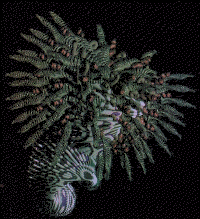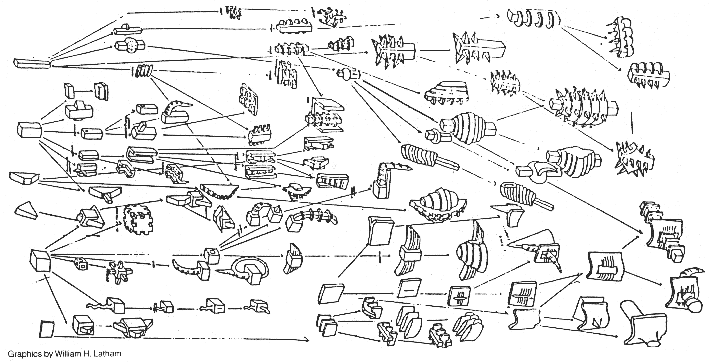Sculptures in the Void |
 |
| One of William Latham's latest works of art |
You can look, but you can't touch. Computers and art meet to produce three-dimensional representations of sculptures that do not actually exist
William Latham
THE SCULPTURES I have been making are ghosts: they exist only
as computer data, and not in physical form. Artists
have made sculptures from many different materials-marble, steel, bricks
and wood-in the workshop or studio. In contrast, I create my sculptures,
or forms, in a "virtual" space viewed through the porthole of a computer
screen. Using the computer, I can rotate and view the forms from any point,
and can simulate visual attributes such as texture, lighting and surface
qualities using techniques that give photographic realism.
The result is a highly realistic representation of
a sculpture that does not exist. The
three-dimensional realism is enhanced by using
stereo projection and animation. The fact that you cannot touch the sculpture,
and that it exists only in virtual space, adds to the mystery of the work
of art. The true significance is not the irony of being unable to touch my
sculpture, but that by working in computer space I can create highly complex
forms that would be impossible in traditional sculpture. This is because
there is no gravity or material resistance. This allows me to explore and
invent forms which had previously been outside my imagination. These forms
I call "computer sculptures".
 |
Part of a hand-drawn evolutionary tree [Click to Expand] |
There is another aspect of the work that is perhaps more interesting. That
is the systematic approach and rules devised with my colleague
Stephen Todd at IBM to generate the forms. These rules are called "form
evolution". Using these rules, there appears to be no limit to the number
of different forms you can produce, from shells to eggs, antlers, slugs and
sea urchins. Although we are creating forms that appear imaginary, poetic
or even "romantic", we are actually using a structured and systematic approach.
I experimented with a system for creating complex sculptures before using
computer graphics. At the Royal College of Art, I developed a way of designing
sculptures called the evolutionary tree. This
approach takes a series of simple operations and carries them out on basic
shapes to create complex forms. Using this method, I drew by hand a chart
of evolutions, measuring 10 metres long by 2 metres high. It became obvious
that my aim of exploring complex forms could well be helped by computer.
Meanwhile, people at the IBM UK Scientific Centre in Winchester were looking
at ways of visualising scientific data, and had developed a variety of systems.
These included a database graphics system for data exploration, and a modeller
called the Winchester Solid Modeller (WINSOM) developed by Peter Quarendon
and others at IBM for data visualisation. WINSOM works with a programming
tool called the Extensible Solid Model Editor (ESME), which was written by
Stephen Todd for experimenting with different picture styles.
 |
A sequence of stills from an animated film called The Evolution of Form Animation |
In 1987, the Scientific Centre commissioned me to produce a
series of computer sculptures using the WINSOM and ESME computer programs.
The results encouraged longer collaboration, aimed at using the computer
for faster form exploration and generation, to widen a sculptor's creative
scope. It became apparent that this work was also interesting to designers
and architects who are similarly involved with problems of modelling complex
forms. The collaboration has two aspects. Using simple programmed operations
(written in the ESME language) helps me explore complex forms. The
photo-realistic techniques of WINSOM allows me to realise and communicate
these forms.
The WINSOM and ESME models are based on the concept of "set-theoretic"
modelling. This can generate solid objects from basic building blocks such
as spheres, which are combined by set-theory operations such as union and
difference. Engineers often use this type of modelling for a variety of
applications.
ESME is a conventional programming language with additional functions that
handle geometry and solid modelling. Two ESME functions provide the operations
used to generate most of my complex forms.
The first of these is the "horn" function, which takes a form and transforms
it many times, creating many different shapes. The variety depends on the
original form, and on the instructions defining a horn; such as bend, scale,
twist, grow and stack. These terms are words that any sculptor would use
when talking to a technician in a traditional studio. The second function
is "branch". This takes a form and produces many copies of it, radiating
from a central point.
Combining these simple functions with the power of set- theoretic modelling
allows me to construct a huge range of forms. There are an infinite number
of sculptures that I could create, but at any given moment the functions
and parameters of the program constrain me to a limited number of choices.
This has proved a very good mixture to encourage creative output, and has
focused my ideas.
None of the forms I have generated at the IBM Scientific Centre has ever
existed as a "real" object They appear as high-resolution screen images or
photographs, or as animations on videotape. As a form develops, I use a variety
of "realisations". The simplest realisation is a sketch, or wireframe which
I can generate very quickly, and can rotate on the screen at will. I use
this to check the basic form and to choose interesting views. Many forms
never progress beyond this stage. Next, using WINSOM, I fill in and colour
the form in three dimensions, in a low-resolution version, to check that
there are no features hidden in a way that was not obvious from the wire
frame. Finally, WINSOM generates a full high-resolution photo-realistic
image.
 |
A simple horn form; a "horn of horns"; branches of cylinders and horns |
To obtain the image, I can use a whole battery of special effects. These
include three-dimensional texturing, shadows, colour and surface qualities.
To use these effects, I set various parameters: these determine the lighting,
or define a style of texturing using fractal
techniques, or describe a special colour or particular "bumpy" surface qualities.
When using these photo-realistic techniques, my intention is to give the
forms a dream-like quality. My forms float in a kind of twilight world halfway
between the real and the imaginary. And as in a dream, they are lit with
a strange eerie glow and have a curious clarity.
We can make the sculptures appear even more three-dimensional using stereoscopic
projection. It is possible to use stereo pairs, with two projectors and
polarising filters. This requires a special screen. Alternatively, a red
and a green image are combined on a single slide. This requires only one
projector, but loses the colour of the image. In either case, the viewer
must wear the appropriate spectacles. Texture is particularly important for
stereo viewing, because it allows greater perception of depth, and enhances
the three-dimensional quality. Animations are much better at giving a viewer
a full appreciation of the form of an object. The simplest type of animation
rotates the form in front of the viewer so that you can see all round it.
More complex animations lead the viewer round, or even through, a form. The
same ESME program that generates the form creates the viewing path. Finally,
the power of animation allows the form itself to grow and distort.
The combination of photo-realism and computer graphics is popular with the
general public and lends itself to mass reproduction and television broadcasts.
As soon as sculptures become "data" then the artwork need not reside in the
art gallery, because the artist can transmit it into the viewer's living
room. In future, we expect to allow users to be more directly involved in
designing the forms. The mathematics of form-generation functions will, however,
still constrain the interaction with the user. There will not be the freedom
associated with "paintbox" systems, such as those used by television companies
to create graphics for maps, diagrams and title sequences. But we will marry
form-generation techniques with my original concept of the evolutionary tree,
to give users a new type of interface. In this way, users will have a quick
and easy way to generate complex forms.
The "form evolution" approach has allowed me to create shapes that had previously
been beyond my imagination, and to present the results to the viewer. As
holography improves, it will be possible to project a full-size sculpture
into the viewer's living room: the ghosts of sculptures will truly appear.
Perhaps we will no longer need to have sculptures in physical form at all.
Techniques to create the nonexistent
COMPUTER sculpture brings together three
techniques: constructive solid geometry modelling, graphical rendering, and
the programming of forms. Significantly, it provides an environment where
these can be applied without the need for detailed technical knowledge. The
techniques were combined for scientific "visualisations", such as molecular
graphics in biochemistry, but also provide a good environment for computer
sculpting. Constructive solid geometry (CSG)-the generation of complex objects
from simple operations on simple objects-was first developed for computer-aided
design applications at the University of Rochester, in the US, in the late
1970s. Research at the University of Bath in England led to the development
of the WINSOM set-theoretic modeller at IBM in 1983, and so to the application
of CSG to visualisation. WINSOM provides a wide range of graphics techniques,
texture being the most important for William Latham's sculptures. 'WINSOM
gives an easy-to-use set of facilities for generating, merging and manipulating
textures. Making complex forms relies on programming rather than building
the forms up piece by piece. The ESME programming tool provides an interactive
programming environment that understands the forms as objects, and is especially
convenient for animation. Researchers at Bath University are now exploring
the use of algebraic programming for geometry.. IBM is working with the
University of Glasgow to look into the use of functional programming both
for shape definition and as a tool for easy control of graphical
algorithms. |